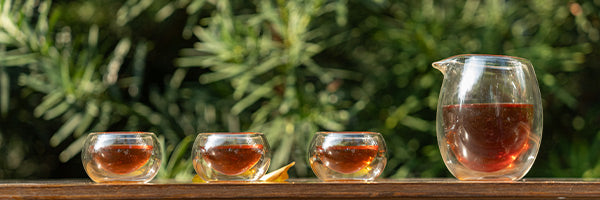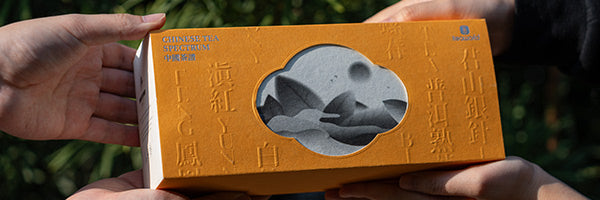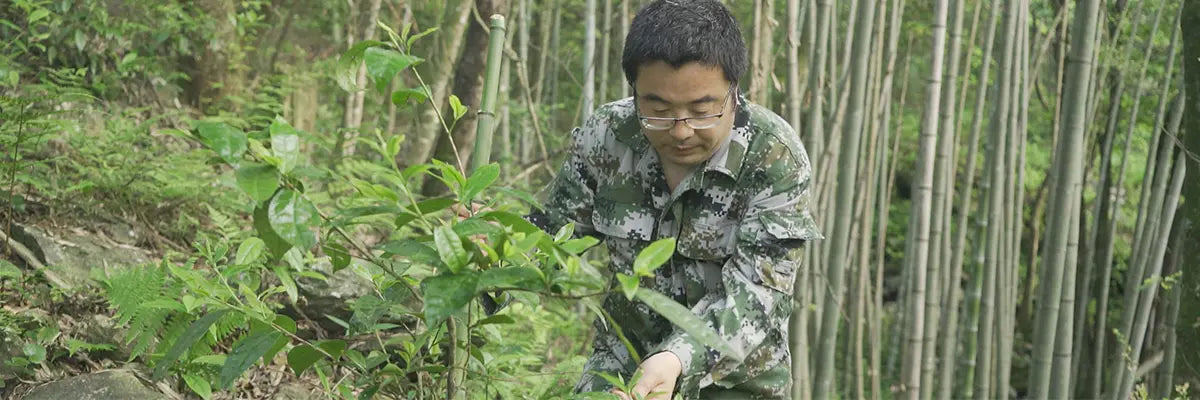О листовом чае улун
Листовой улун — это тип полуокисленного чая, занимающий промежуточное положение между листовым зеленым чаем и листовым черным чаем, высоко ценимый за свои уникальные методы обработки. Основные процессы производства листового улуна включают завяливание, встряхивание или скручивание, фиксацию, скручивание и выпечку.
Листья рассыпного чая улун могут иметь различную форму, например, в форме шара или полоски. Различные регионы, где производится рассыпной чай улун, такие как Фуцзянь, Гуандун, Тайвань и т. д., наделяют чайные листья уникальными вкусами и ароматами благодаря своим особым местным условиям и традиционному мастерству. Это делает рассыпной чай улун любимым сортом среди любителей чая. С широким выбором видов чая улун рекомендуется изучить свои предпочтения, купив пробник чая .

История листового чая улун
Листовой чай улун родом из провинции Фуцзянь и имеет более чем 1000-летнюю историю.
Формирование и развитие листового улуна можно проследить до чая Бэйюань. Чай Бэйюань является самым ранним чаем-данью в Фуцзяне и стал самым известным чаем после династии Сун. Существует более десяти исторических работ, знакомящих с производством и завариванием чая Бэйюань. Бэйюань — это район вокруг горы Фэнхуан в Цзяноу, провинция Фуцзянь, и производство чая в этом регионе восходит к концу династии Тан.
Аромат листового чая улун
Листовой улун славится своим ароматом. В настоящее время в чайных листьях обнаружено более 700 ароматических соединений, а листовой улун содержит более 300, превосходя другие виды чая. Завораживающий аромат улуна — одна из причин, по которой он считается одним из лучших листовых чаев .
Уникальная технология обработки, известная как «встряхивание или прокатка Цзоцин» используется исключительно для листового чая улун и является ключевым фактором в формировании качества и стиля чая улун. Отличительный аромат листового чая улун развивается во время этого процесса, что привело к поговорке среди фермеров, выращивающих чай: «Встряхивание рек и опрокидывание морей дает чай улун».
Аромат листового улуна можно в целом разделить на цветочные, фруктовые, медовые, угольные, прозрачные и ароматы орхидеи и т. д. Также существует множество уникальных подтипов при дальнейшей очистке. При выборе листового улуна можно сделать выбор на основе предпочитаемых ароматических профилей.
Выбор чая улун по регионам производства
Листовой улун в основном поставляется из четырех регионов производства: Миннань, Минбэй, Гуандун и Тайвань. В каждом регионе есть несколько репрезентативных сортов листового улуна. 
1. Миньнань улун
Миннань, расположенный в южной части провинции Фуцзянь, является одним из мест рождения листового улуна. Плодородная почва и богатое разнообразие растений делают его прекрасным регионом для производства высококачественного листового улуна. Чай Аньси ТеГуаньинь заслуживает внимания, он известен своим насыщенным цветочным ароматом, уникальным вкусом и длительным послевкусием.
2. Минбэй Улун
Минбэй, расположенный в северной части провинции Фуцзянь, характеризуется своим «каменным очарованием», а Да Хун Пао является представителем северного фуцзяньского улуна. Чайные деревья растут среди камней в горах, а производимый улун известен как «каменный чай».
3. Гуандунский улун
Гуандунский улун славится своим элегантным внешним видом, душистым ароматом и гладкой текстурой. «Горное очарование» является отличительной чертой гуандунского улуна, а чай Фэнхуан Даньцун является его представителем.
4. Тайваньский улун
Чайные сады на Тайване обычно располагаются на высоте более 1200 метров, с прохладным климатом и обильными осадками, что обеспечивает идеальные условия для роста чайных деревьев. Что касается обработки, Тайвань делает упор на ручное мастерство, что приводит к тонкому вкусу и ограниченному, но высококачественному производству. Типичные сорта тайваньского улуна включают Дун Дин Улун и Фэнхуан Даньцун.
Знакомство со знаменитыми чаями улун
1. Те Гуаньинь
TieGuanyin родом из Аньси, провинция Фуцзянь, и входит в десятку самых известных чаев Китая. Чайные листья TieGuanyin плотно скручены, имеют песочно-зеленый цвет. Он обладает богатым и стойким ароматом, мягким и сладким вкусом.
2. Да Хун Пао
Да Хун Пао произрастает на горе Уи в провинции Фуцзянь и считается «Королем чая». Чайные листья плотно скручены и имеют равномерную структуру, демонстрируя зеленовато-коричневый и блестящий вид. Да Хун Пао имеет стойкий и душистый аромат с мягким и сладким вкусом.
3. Фэнхуан Даньцун

Fenghuang Dancong производится в горах Фэнхуан, Чаочжоу, Гуандун, и известен своим уникальным горным очарованием и цветочным ароматом. Чайные листья крепкие, плотно скрученные, имеют желто-коричневый и маслянистый блеск. Он имеет чистый и стойкий аромат со свежим и сладким послевкусием.
4. Дун Дин Улун
Dong Ding Oolong произрастает на горе Дун Дин в Тайване и считается представителем тайваньского улуна. Плотно скрученные чайные листья скручены, имеют темно-зеленый и маслянистый вид. Он имеет чистый и элегантный аромат, который сохраняется, с мягким и сладким вкусом.
5. Цзинь Сюань Улун
Jin Xuan Oolong производится в регионе Алишань на Тайване и имеет уникальный молочный и османтусовый аромат. Чайные листья плотно скручены и равномерно структурированы, представляя живой песчано-зеленый цвет. Он имеет сильный и стойкий аромат со свежим и сладким послевкусием.
6. Чжанпин Шуйсянь

Zhangping Shuixian родом из города Чжанпин провинции Фуцзянь, и это единственный прессованный чай среди улунских чаев. Он имеет сильный и стойкий аромат, отличающийся натуральным цветочным ароматом, напоминающим орхидеи. Вкус мягкий, освежающий и изысканный.
Найдите больше листового чая улун с помощью нашего пробника чая улун.>>>

Метод заваривания листового чая улун
Правильный метод заваривания может усилить наслаждение от рассыпного чая улун. Здесь мы предлагаем относительно простой метод заваривания. Если вы хотите улучшить свои навыки заваривания рассыпного чая улун, в Интернете доступно множество подробных видео по завариванию для справки и обучения. 
1. Перед завариванием желательно ополоснуть чайную посуду кипятком для повышения температуры и чистоты. Кроме того, прогревание посуды помогает усилить аромат и вкус листового чая .
2. Поместите чайные листья в чашу или чайник с крышкой. Количество чайных листьев можно регулировать в зависимости от личных вкусовых предпочтений и качества чая, обычно оно составляет от 5 до 10 граммов.
3. Налейте горячую воду (95–100 °C) в закрытую крышкой пиалу или чайник, стараясь не лить воду прямо на чайные листья, чтобы не повлиять на вкус и качество чая.
4. Подождите около 10 секунд, затем вылейте чайный ликер в чашку fairness. Затем вылейте чай из чашки fairness в маленькую чашку, и он готов к употреблению.
5. Высококачественный листовой улун можно заваривать многократно, до 7 и более заварок. Время заваривания последующих заварок можно увеличивать по желанию.
Польза для здоровья листового чая улун
1. Освежает разум и улучшает мышление
Листовой чай улун содержит кофеин, который стимулирует центральную нервную систему и улучшает когнитивные функции. Регулярное употребление листового чая улун может помочь повысить бдительность, снять раздражительность и снять усталость. Он особенно подходит для людей, которые сталкиваются с усталостью во время работы.
2. Управление весом
Компоненты дубильной кислоты в листовом чае улун играют важную роль в обмене веществ, стимулируя активность панкреатической липазы, снижая усвоение углеводов и жиров и ускоряя выработку калорий организмом. Это способствует сжиганию жира, что приводит к значительному эффекту контроля веса.
3. Профилактика рака
Исследования показывают, что листовой улун богат катехинами, витаминами и другими компонентами, которые могут подавлять синтез канцерогенных нитрозаминов. Это делает его полезным для профилактики рака, предоставляя натуральный и полезный вариант чая.
Каждый сорт листового улуна несет в себе уникальные вкусы и суть традиционного мастерства, что делает его достойным изучения и наслаждения. Независимо от того, ищете ли вы освежающий вкус или насыщенный аромат, удовлетворение можно найти в разнообразном выборе листового улуна. Давайте погрузимся в мир улуна, оценим его уникальное очарование и насладимся удовольствием, которое приносит аромат чая.












































































